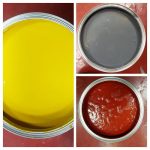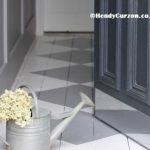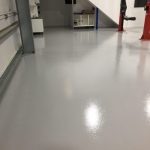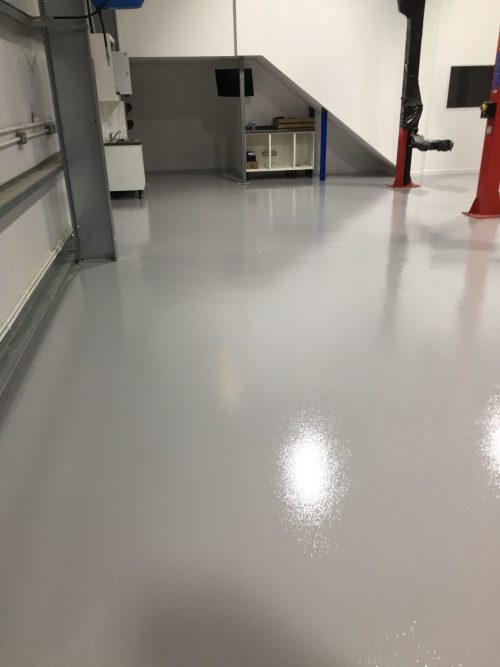All Blogs, Colour, Priming and Protecting
Which Paint to Use on Which Floors?
 Which paint to use on floors? Well obviously that is entirely up to you and your tastes. But yes, you can paint wooden and concrete floors! Here are our tips and advice the kinds of coatings you should consider using and how to apply them. Here we’re talking about both wood and concrete floors (we’ll be a looking at other surfaces in future blogs).
Which paint to use on floors? Well obviously that is entirely up to you and your tastes. But yes, you can paint wooden and concrete floors! Here are our tips and advice the kinds of coatings you should consider using and how to apply them. Here we’re talking about both wood and concrete floors (we’ll be a looking at other surfaces in future blogs).
Why Paint a Floor?
There are many reasons why you might want to choose to paint a floor – from aesthetics, through to practicality and of course finances. Whether your floor is wood or concrete, there are actually many great looks you can achieve using colour, with a painted floor:
- Pastels – Great for a shabby chic look
- Whites – Work well for Scandinavian and nautical inspired themes
- Pales and whites – Ideal for a stark minimalist and for a soft contemporary look
- Both dark and light colours – With scattered rugs for country cottage and traditional themes
- Dark – Good for an industrial/steam punk appearance
- Brights – Work well in playrooms and kitchens etc
- Designs – Using stencils to create striking geometric patterns, stripes, checks etc.
Painting a Wooden Floor
 Why would you paint a wood floor when you could sand it and varnish it to show off its natural beauty? Well if the floor is truly beautiful, keeping it natural is usually the preferred option. A proper sanding and a few coats of a good gloss or satin/eggshell varnish (like our Polyurethane Floor Varnish) will do the job. Don’t take short cuts (yes we’ve all been there)…sand it really well and remove all dust and debris before thinking about starting to varnish. Allow each coat of varnish to dry before applying subsequent coats. Not all wooden floors are that beautiful however and if you’ve ever removed a carpet to see what’s underneath, you’ll know that they come in all sorts of states. Too many holes, cracks, signs of previous paints and treatments. water stains, or simply poor quality floorboards; these may all send you straight back to covering it up with a carpet. Alternatively you might want to think about giving it a good sanding back, followed by any essential treatment with wood fillers and knot sealers. Then coat with floor paint in neutral, bold or bright colours. It may be that other flooring options don’t give you the look you want or can afford. In which case, floor paint opens up fabulous possibilities for you. The image shows a wooden floor in a hallway painted white and grey courtesy of Hendy Curzon
Why would you paint a wood floor when you could sand it and varnish it to show off its natural beauty? Well if the floor is truly beautiful, keeping it natural is usually the preferred option. A proper sanding and a few coats of a good gloss or satin/eggshell varnish (like our Polyurethane Floor Varnish) will do the job. Don’t take short cuts (yes we’ve all been there)…sand it really well and remove all dust and debris before thinking about starting to varnish. Allow each coat of varnish to dry before applying subsequent coats. Not all wooden floors are that beautiful however and if you’ve ever removed a carpet to see what’s underneath, you’ll know that they come in all sorts of states. Too many holes, cracks, signs of previous paints and treatments. water stains, or simply poor quality floorboards; these may all send you straight back to covering it up with a carpet. Alternatively you might want to think about giving it a good sanding back, followed by any essential treatment with wood fillers and knot sealers. Then coat with floor paint in neutral, bold or bright colours. It may be that other flooring options don’t give you the look you want or can afford. In which case, floor paint opens up fabulous possibilities for you. The image shows a wooden floor in a hallway painted white and grey courtesy of Hendy Curzon
The Right Paint for a Wooden Floor?
If you decide to paint a wooden floor, a gloss or satin finish will work best. A matt finish on a floor may appear ‘dull’ which visitors might equate to ‘dirty’ if not done correctly. Which floor paint? While you can purchase special floor paints a good quality oil based gloss (like our Truglos) will do the job perfectly well. You may want to top with a coat of polyurethane floor varnish for extra protection. You could also consider a polyurethane floor paint as another alternative. While ‘sock skating’ is a great sport at any age, if you’re worried about slipping, you could also ask for antislip addititive.
How to Paint your Wooden Floor
It may seem labour intensive but it’s really straightforward:
- Remove…nails, tacks, screws etc. They will ruin your sander
- Sand..well. It’s a chore, but it is vital if you want your floor to look good (consider hiring a professional sander for a day)
- Repair…any cracks with wood filler and seal knots with a knotting solution, then give it another light sanding
- Clean…sweep, then vacuum and then wipe with a damp cloth to make sure all the dust has cleared
- Seal or Prime…depending on the type of paint you choose, you may need a sealer or primer. Check the label or ask the manufucturer. (We advise using our All Purpose Primer when using our Truglos or Palatine Professional Satin/Matt)
- Apply…a thin coat of paint. A roller is the quickest – something like our solvent resistant floor painting roller with its long handle will be fine
- Allow…to dry and obviously don’t walk on it – this may take up to 24 hours
- Sand again…sometimes it’s advisable to lightly sand after this first coat
- Apply…a second coat and again allow to fully cure.
- Once you’re sure…it’s completely dry apply a coat of Polyurethane Floor Varnish and ideally leave for a few days before using the room
Painting a Concrete Floor
You may be wondering why you’d want to paint a concrete floor. Usually it’s far more practical to have a protective surface that you can keep clean and if it’s somewhere that you’re going to spend time, like a workshop, garage, utility room or perhaps an outdoor office/studio, then you may want a more decorative look anyway without the expense or impracticality of an alternative floor covering. A painted concrete floor will be easy to keep clean, will stop that concrete dust getting everywhere and can look really good if done well!
Choosing the Right Paint for a Concrete Floor
 With a concrete floor, the purpose of your room or space will have more of a bearing on the type of paint you choose. If it’s for a well used area like a warehouse or workshop, or even a garage, you’ll need to consider the amount of traffic (vehicular and pedestrian) the floor is likely to get. Spillages from chemicals, oils and grease may also be a factor. If you’re painting kennels, chicken housing etc you may want to consider the best coating for protection from urine and fouling. A paint that will cope with regular hosing or jet washing may also influence your decision in the latter case. So let’s run through just a few of the many concrete floor paints and why you might use them
With a concrete floor, the purpose of your room or space will have more of a bearing on the type of paint you choose. If it’s for a well used area like a warehouse or workshop, or even a garage, you’ll need to consider the amount of traffic (vehicular and pedestrian) the floor is likely to get. Spillages from chemicals, oils and grease may also be a factor. If you’re painting kennels, chicken housing etc you may want to consider the best coating for protection from urine and fouling. A paint that will cope with regular hosing or jet washing may also influence your decision in the latter case. So let’s run through just a few of the many concrete floor paints and why you might use them
Polyurethane Floor Paint
These coatings (Carbotread is our version) are hard wearing and are a good economical solution for sprucing up tired looking garages, showrooms, warehouses and factory floors. They are easy to clean and hard wearing with good resistance to moisture, scuffs and abrasion. They may not stand up to serious chemical spillages, cleaning with harsh chemicals and very heavy vehicular traffic. Polyurethane floor paints can be solvent based or water based. If using a solvent based floor paint make sure you ventilate effectively. The moisture content of the concrete is a big factor in the successful application of a single pack PU paint. Concrete must be well matured (4 weeks old at the very least), completely dry, with a moisture content of less than 8%. The application must also be carried out in moisture free conditions.
How to Apply a Polyurethane Paint to Concrete
- Ensure concrete is well matured (see above)
- Remove any surface dust
- Clean traces of grease or oil with multi purpose thinners
- If concrete is really smooth or has surface ‘laitance’, treat with a concrete etching fluid (this will help adhesion)
- If you’ve treated with etching fluid be sure to wash thoroughly and allow to dry completely before painting
- (If a floor has previously been painted, roughly abrade by sanding)
- Dilute your first coat with up to 20% white spirit by volume which will seal the concrete surface
- Once dried, apply a second coat at full strength. On previously painted floors apply two thin coats.
Epoxy Resin Floor Paints
Widely used in industrial/commercial situations, epoxy floor coatings are hard wearing, durable and able to withstand heavier/frequent traffic use. Epoxy floor paints are usually two components (an epoxy resin and a hardener) that are mixed prior to application. Two pack epoxy floor paints do not require much maintenance and can withstand chemical spillages and powerful cleaners. Epoxy paints are known to be less UV stable than some alternatives, so if you are painting a floor near large windows or doors which maybe left fully opened especially in good weather, choose a colour which won’t be affected by potential ‘yellowing’ There’s a wide variety of epoxy floor coatings available including solvent based, solvent free, water dispersible. Seek advice from your supplier (we’re always happy to help here at Palatine Paints) so you can be sure you’re getting the right paint for your intended use.
How to Apply Two Pack Epoxy Floor Paints
See manufacturer’s advice for specific products but in general, treat the concrete as describe above. Depending on the type of epoxy product you choose, you may be able to use on newer concrete than the PU paint described above. (Epoxy water dispersible paint can be used on concrete at least 14 days old or moisture content less than 10% for example).
- Patch surface repairs with an epoxy patch repair system
- Two pack epoxies are normally supplied pre-weighed ready for mixing
- Check the ‘pot life’ ! One big word of warning…check the ‘pot life’ and be ready to apply the paint once you’ve mixed the ingredients. The pot life is the amount of time the product is usable after the components have been mixed together. The paint will be un-usable once its past its pot life which can be as little as 40 minutes
- Stir the individual components before mixing them together
- After mixing stir for at least 5 minutes
- Thin the first coating if advised by the manufacturer and apply with a roller
- Apply the second coat within 24 hours and preferably as soon as the first coat is touch dry.
Chlorinated Rubber Paint on Floors
 If you’re thinking of painting an area where hygiene is essential, where frequent washing is required and where chemical resistance is a must, then you may want to consider chlorinated rubber paint. Because it is very hard wearing, heat resistant, low maintenance and resistant to oils, urine/chemicals and heavy traffic, it is a good choice for many areas. If you’re lucky enough to have a swimming pool, chlorinated rubber paint is a great pool/pool room floor paint. It’s also a really reliable choice for kennels, livestock areas, feed storage areas, washrooms, and utility rooms etc.
If you’re thinking of painting an area where hygiene is essential, where frequent washing is required and where chemical resistance is a must, then you may want to consider chlorinated rubber paint. Because it is very hard wearing, heat resistant, low maintenance and resistant to oils, urine/chemicals and heavy traffic, it is a good choice for many areas. If you’re lucky enough to have a swimming pool, chlorinated rubber paint is a great pool/pool room floor paint. It’s also a really reliable choice for kennels, livestock areas, feed storage areas, washrooms, and utility rooms etc.
How to Apply Chlorinated Rubber Paint
Application is straight forward but it’s crucial that you follow the manufacturer’s guidelines to avoid peeling or bubbling paint. Also note that when applying indoors, you need to make sure the area is very WELL-VENTILATED. Use a suitable mask or respirator. Leave a couple of days before using the painted area if you can, especially if it’s indoors in a room where ventilation is not easy.
- Prepare the surface thoroughly removing all grease, grime and dirt and repairing any cracks
- Ensure the paint is applied at temperatures between 10ºC and 25ºC
- Ensure surface is dry to ensure paint adheres effectively – also applies between coats
- Apply a minimum of two coats with a solvent resistant roller or brush
- More information about chlorinated rubber paint can be found in our Blog Here
Some more tips on choosing a colour for your floor
The ideas above mentioned achieving a certain style with colour. So, obviously have a think about the style you want and choose a colour that relates to your style. There are other aspects might also want to consider: What’s the room going to be used for? Colour affects your mood. It may sound like psychobabble but there is some evidence in this. We looked into this in a bit more detail and created a light hearted feature all about How to Choose a Paint Colour here How big is your room? If it is spacious, you can get away with practically any colour but a harsh white could make it seem cold and cavernous. Consider a warmer or darker shade if you want to retain a cosy atmosphere. Similarly, a smaller room can be made to appear bigger with a paler or neutral shade. How much natural light do you have? Lots of big windows or skylights will allow a greater choice of colours. And you will have the advantage of a slightly different shade depending on the time of day. Some colours can look completely different in natural light than in artificial light. We hope this has helped you. Contact us if you’re unsure about anything and if you have painted your floors with any of our paints, we’d love to see your pictures. Email them – or find us on Facebook, Twitter, Instagram or Pinterest and post them for us. Finally, here is our floor coatings section if you need to take a look at the products in more detail. If you are thinking of simply sealing your concrete floor to dust proof and protect it, read our blog on Why It Is Important To Seal Concrete & Masonry Surfaces


This is a very informative article!!
Thank you very much for sharing this nice post. Painted concrete floors look great on any floor in your home including the garage, basement, living room, patio or balcony. You can stain, paint, decorate, age, pattern or etch your concrete floor to get the look you want, one layer at a time.
I want to appreciate your time and effort for sharing amazing blog. “Which paint to use on floors? Well, obviously that is entirely up to you and your tastes”. I read your blog, it’s very interesting. Looking forward for your new blogs.
Thanks for the great info. Raising the floor level up above the ground acts as a barrier to damp coming up from the ground. … These days most homes are designed with concrete floors because damp proofing technology allows us to create a dry floor without an air gap.
This blog Can I paint a floor? And what with? helps me a lot with my woodworking projects.